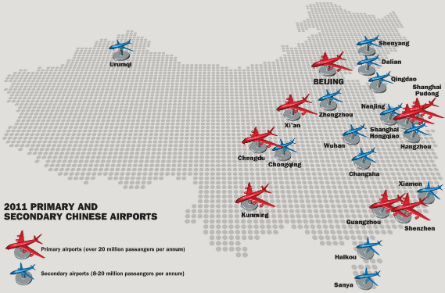While the story of growth at the main Chinese hubs of Shanghai, Beijing, Guangzhou and Hong Kong is well known, airline interest has started to focus on how both Chinese and foreign carriers will now seek to address the growing aviation needs of the Chinese secondary markets.
China already has more than 120 cities with populations over 1 million. With traffic growth in double digits, inevitably these will only be restricted for so long to connecting international services via hubs.
The secondary airports' passenger traffic growth rates are significant, and they are becoming increasingly aggressive in their objectives for international service expansion. The secondary Chinese airports - classified here as those with passenger traffic of 8-20 million per annum - have shown average growth of around 15% per year over the last five years. In 2011, secondary Chinese airports - which includes 5.6% of total Chinese airports - contributed 18.5% of total passenger traffic.
A NEW HOT SPOT
As communication increased between Europe and China, air transportation between the two markets became a hot spot to explore. As of 2011, however, the majority of Europe-China routes were still mainly dominated by the three major airports - Hong Kong, Beijing and Shanghai.
Secondary airports still lag far behind the primary airports in European route development - which implies the potential room for growth. Increasingly, more secondary Chinese airports are looking to launch routes not only within Asia, but also to Europe. Plus, given the east coast concentration of the hubs, the airports in the west of the country have a definite advantage for development. European airports are also hopeful of finding ways to attract airlines which service the lucrative Chinese markets. However, often the local market of a Chinese secondary airport is just not substantial enough to support a new route to Europe.
 |
|---|
The situation does, however, change significantly when connections to the China domestic market are considered. Thus, the challenge becomes how to leverage Chinese domestic traffic growth at the airport for connection to European points.
Given the current challenges facing European airlines, it seems the best hope for these Chinese airports will lie with Chinese carriers for the immediate future.
IDENTIFYING TARGETS
The development of such services has been patchy, and often only supported by start-up incentives. The need is often for a detailed forecast, combined with a connectivity analysis to identify the most robust targets and the likely risks. Any airline persuaded to serve a weaker destination airport will not last long.
Recent discussions in the industry regarding airport-airline relationships in China have often covered quality of maintenance for existing airline operations. For the sustainability of business development, airports should perhaps be encouraged to step into the airline world, to understand the various airline and alliance global strategies. The airport network and its market potential is dynamic, and this can also influence an airline's potential network development.
The regional secondary airport of today may become the growth target of tomorrow. Consequently, airlines want to hear of the market's potential from the airport operators - as well as arguments as to why the airport network and its market potential will fit into their global network.
So far most of the secondary Chinese airports are yet to systematically evaluate their own market potential for international long-haul connections. In this regard an OODA (observe, orient, decide and act) working approach would probably be most suitable for these airports.
This would allow them to find their potential market, evaluate the current situation, identify priority opportunities, produce and review traffic forecasts and customise their service marketing plan for approaching different airline customers. Using this approach the airport operators could be more engaged in an airline's strategy, and could therefore look forward to increased competition for business, and a greater choice of flight options for consumers in Europe and China.
At the same time the big three Middle East carriers will increasingly look to serve the secondary airports, and this is already starting to happen.
Source: Air Transport Intelligence news
















